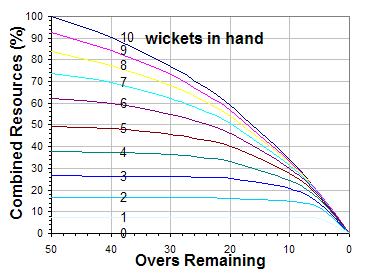 As Ishank Jaggi scored the winning run off the bowling of Bipul Sharma, KKR were through the qualifier and the defending champions were knocked out of the tournament. KKR won the game by achieving the revised target of 48 runs in 6 overs set by the DLS method.
As Ishank Jaggi scored the winning run off the bowling of Bipul Sharma, KKR were through the qualifier and the defending champions were knocked out of the tournament. KKR won the game by achieving the revised target of 48 runs in 6 overs set by the DLS method.
After the match finished there was much speculation about the validity of DLS method in a T20 game. Is it worth to constitute a complete game in just 5 overs? Certainly not, as team batting second would throw everything to achieve the target.
The DLS method (previously D/L method) is an insightful tool to be used in rain-curtailed 50-over matches. The D/L method was introduced by Frank Duckworth and Tony Lewis after the outcome of 1992 world cup semi-final between ENG and SA where “most productive over” (MPO) method was used and SA were finally left stranded to score 22 runs of the last ball and were knocked out.
The D/L method cleverly combined overs remaining and wickets in hand into a single combined resource. It wasn't easy to model this complex interplay between the two resources, but Duckworth and Lewis did it quite brilliantly. Better still, their method solved the vexing problem of during-the-innings interruptions.
Over the years, the D/L method has become even better, especially after the Professional Edition, which required the use of a computer, was introduced. It would be fair to say that the method now resolves interruptions in 50-over matches almost perfectly.
The Duckworth-Lewis System combines the remaining wickets and deliveries into a single resource. In the event that the regulated number of overs cannot be bowled, the target that a team needs to reach is recalculated to account for the resources lost during the break.

Graph showing the Duckworth-Lewis calculation for combining remaining wickets and deliveries into a single resource. Source: Wikipedia
For example, consider a 50-over game in which Team A bats first and scores a total of 200 runs in 50 overs. Team B then begins its innings, and scores 50 runs in ten overs while losing three wickets. The game is then abandoned for whatever reason with Team B unable to complete its innings.
The Duckworth-Lewis method would say that Team A had used 100% of its available resources (since it faced all 50 possible overs) whereas Team B had used only 30.4% of its resources. The game would then be decided by which team had scored the most runs, allowing for Team B’s lost resources.
Team A’s score of 200 would then be multiplied by the ratio of each team’s available resources (30.4/100) to give a target of 60.8 runs to be reached by Team B. As Team B scored only 50 runs, Team A would be declared the winners.
Now, back to T20 games, The ICC playing condition states that 5 overs are sufficient to constitute a match. This seems to be fair if both teams get to play 5 overs from the beginning. If a team has played the full innings and due to rain the team batting second has to play only 5-6 overs would have an added advantage for the chasing team. D/L/S is notoriously famous for favouring the team batting second and this is magnified during a T20. In the match between KKR and SRH, KKR knew they had to score only 48 runs with all 10 wickets in hand. Even if SRH had the best possible attack in the world it would have been next to impossible to defend 48 runs will all 10 wickets intact.
This is the topic of another debate why IPL does not have a reserve day for the playoffs (including final). Would there have been a reserve day and the game would be played from where rain has interrupted, SRH had a better chance with a quality attack on a tricky surface.
Critics of the Duckworth-Lewis method in Twenty20 cricket focus on two issues. First, by focusing on preserving resources, the system does not directly attempt to preserve winning probabilities.
That is, a team’s chances of victory before and after a delay might be greatly different because of the formula alone. This is seen by many critics as rather a perverse idea, but it is one that Duckworth and Lewis admit was intentional and have vocally defended. Alternative metrics, including some that seek to preserve winning probabilities have been proposed.
The bigger issue with applying the Duckworth-Lewis method to Twenty20 is simpler; it was not developed or calibrated for this shorter version of the game. The calculations assigning relative importance to wickets and remaining deliveries have been developed for the 50-over format.
It is often argued that wickets are relatively less valuable in Twenty20, as most teams are ultimately limited by the number of deliveries before they run out of wickets. In longer versions of the game, the necessity to keep wickets in hand is more important.
There are a few examples to show that D/L/S method needs to be revised for T20 games.
England v West Indies, World Twenty20, 2010
England's score of 191 in 20 turned out to be a losing one after D/L decided that West Indies' revised target in six overs was 60. WI chased that down with one ball to spare.
As WI had to score only 60 runs from 6 overs, it became a lot easier than to score 192 in 20 overs with all 10 wickets in hand.
England v West Indies, World Twenty20, 2009
This time England scored 161, and West Indies got only nine overs in their innings, with their revised target being 80. This time also WI came out victorious.
Overall, the Twenty20 calculations suffer because of lack of matches - an issue that will be resolved as more matches are added to the database - and by the need to have a complete match for as few as five overs. A sensible solution would be to insist on at least 10 overs per side for a valid game or as former New Zealand captain Stephen Fleming suggested to introduce the ‘wicket pressure’, so if a team has a small chase it also has to fewer wickets to play with. In effect that means a team will have only five wickets in hand for a five or six over chase.
The rules and methods are there for betterment of the game and to obtain results in order to provide joy to the spectators who want their favourite team to win but these rules need to be revised if they are not doing good for the game. ICC must consider this.
Fast. Lite. Innovative. Shareable. Download our HW Cricket App, for Android and iOS!